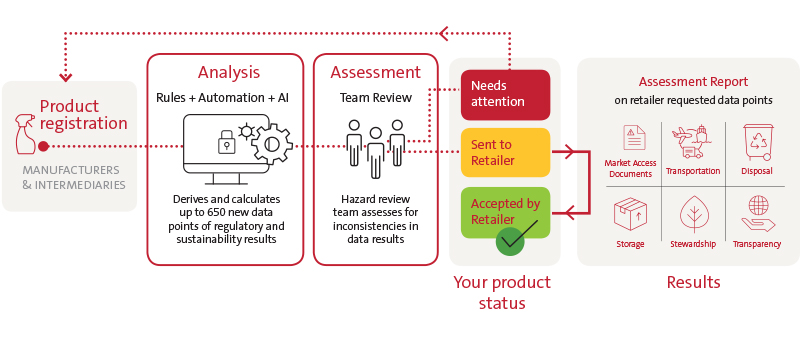What happens during a product compliance assessment review?
Print
Modified on: Thu, 30 Jan, 2025 at 12:34 PM

A common question that has been coming up in recent months is how products are assessed for their potential hazards. This article will explain the product assessment process, its quality control practices, and how the results help ensure data accuracy to enable compliance for all participants in the WERCSmart program.
Overview
During the product registration process, brands and manufacturers, distributors, and 3rd party formulators (all commonly referred to within the program as “suppliers”) are asked to provide product data such as chemical composition, physical properties, transportation-related information, as well as various safety and certification documents like Safety Data Sheets (SDS).
Based on the data provided by the Supplier, the WERCSmart engine derives over 650 new data points of regulatory and sustainability results. This information allows a retailer to confidently know how to manage complex federal, state, provincial, and local regulations to sell, handle, store, transport, and dispose of their chemical-based products and how those products perform against a retailers’ chemical policy.

The Product Assessment Review is a 3-step process:
1. Data Entry & Derivations:
Suppliers come to our secure platform to disclose information about a product. Based on the product's recommended use and formulation information, our proprietary algorithm – composed of thousands of complex rules – compares document data and pictograms provided in the SDS to the additional product data entered as part of the registration process. The results are then screened against the most up-to-date regional and global regulations to produce the results needed by the retailer to properly handle, transport, and dispose of chemical-containing products. This is the stage in the process where data integrity is established and/or inconsistencies are discovered.
2. Regulatory Review & Assessment
Once the automation has derived results, those results move to our Hazard Review Assessment team. The Hazard Assessment team is made aware of any discrepancies that were identified in the automation phase of the process for further investigation. Since federal, state, provincial, and local regulations are always changing, human review acts as an additional quality control point essential for verifying data accuracy. When the hazard review completes their work, there are 3 possible outcomes:
I. Sent to Retailer – After the Assessment stage is complete, products with a status indicating “sent to retailer” within your product management dashboard means that we found no inconsistencies in the review process and the derived results were shared with the retailer(s) you specified in the process as recipients of your data.
II. Accepted by Retailer – Once a retail partner accepts the report containing your derived results, the status will change to “Accepted by retailer”.
III. Needs Attention – If an inconsistency is discovered, the product is put on hold and the supplier is alerted by listing their product’s status as “Needs Attention” in the WERCSmart product management dashboard. The supplier is then able to remedy any issues by resubmitting the registration after the necessary adjustments are made. Results are not reported to retail partners until consistent data is assessed.
3. Distribution of Results to participating Retailers:
WERCSmart derives over 650 new data points of regulatory and sustainability results based on a consistent set of information provided during product registration. The actual number of data points provided in a retailer’s Assessment Report is dependent upon each retailer’s requirements that are necessary to support their own individual regulatory compliance and sustainability programs.
For example, if Retailer A uses the WERCSmart program exclusively to have easy access to safety documents, they would require far fewer data points than Retailer B who uses WERCSmart results as part of a corporate-wide program for waste classification identification and sorting management.
The most common uses of WERCSmart results are:
• Regulatory compliance
• Instruction for proper shipment
• Waste management programs
• Distribution center slotting guidance
• Identifying restricted products
• Assist in sustainability initiatives for Retailers and Suppliers
It’s important to note that the product composition information provided by suppliers is never accessible or visible to retail partners. All confidential information disclosed as part of the product registration process remains protected within WERCSmart. Retailers only receive the calculated results which are, in turn, used as a necessary part of their compliance and chemical policy programs.
Did you find it helpful?
Yes
No
Send feedback Sorry we couldn't be helpful. Help us improve this article with your feedback.


